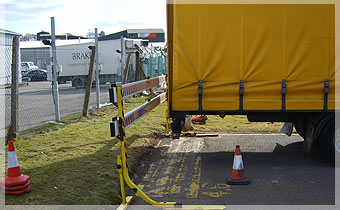 |
|||||||||||||||||||||||||||||||||||||||||||||
|
|||||||||||||||||||||||||||||||||||||||||||||
LGV & PCV Driving Tests in Inverness & North of Scotland |
| LGV/PCV hazard perception test | After passing the theory test | |
| First, you will be shown a short video clip about how the hazard perception part works. You will be presented with 19 video clips which feature everyday road scenes. In each clip there will be at least one developing hazard, but one of the clips will feature two developing hazards. Each clip will last approximately one minute. To achieve a high score you will need to respond to the developing hazard during the early part of its development. The maximum points you can score on each hazard is five. You will not be able to review your answers to the hazard perception test: as in reality, you will only have one chance to respond to the developing hazard on the road. The pass mark for the hazard perception part of the theory test is 67 out of 100. At the end of the hazard perception part of the theory test you’ll be invited to answer a number of customer survey questions. You don't have to answer the questions if you do not want to and any information given is anonymous and confidential. The survey questions don't affect the result of the test. |
You will receive an embossed pass letter detailing the results for the part of the theory test you have completed. When you have passed both parts, you will receive your theory test certificate which has your theory test number on it. You will need this number when you book your practical test. Your theory test certificate is valid for two years from the date you passed the first part of the test. If you do not pass your practical test within this two year period, you will have to take another theory test. There are no exceptions to this rule. |
|
| At the end of the test | If you fail the theory test | |
| When you have finished the test you may leave the examination room. Once you have left the room, you won’t be allowed to enter it again. You will be given your result and feedback information within 10 minutes of finishing the test. | If you fail you should look at the feedback given on the letter and identify why you failed. If you want to book another theory test you can book a test straight away, but you cannot take the test for another three clear working days. So, if you failed your first test on Monday afternoon, you will have to wait until Friday morning before you can take your next theory test. | |
| Practical Road Driving | LGV / PCV multiple choice test | |||||||||||||||||||||||||||||||||||||
| During your practical road driving, the examiner will see how you: • Use the vehicle controls • Move away at an angle, uphill and downhill • Use the mirrors • Give appropriate signals • Show awareness and anticipation of other road users intentions • Manage your progress and control your vehicle speed • Deal with hazards • Select a safe place to stop There will also be 10 minutes of independent driving, designed to test your ability to drive safely while making independent decisions. |
Before the test starts you will be given instructions on how the test works. You can also choose to go through a practice session of the multiple choice questions to get used to the layout of the test. At the end of the practice session the real test will begin. When you take the LGV / PCV multiple choice theory test you’ll be asked some specific questions relating to the category of test being taken, as well as questions that apply to all road users. A question and several answer options will appear on-screen and you have to select the correct answer to the question by touching the screen or using the mouse. Some questions may require more than one answer. You will be asked 100 questions in 115 minutes. You can navigate between questions and ‘flag’ questions that you want to come back to later in the test. The pass mark for the multiple choice part of the theory test is 85 out of 100.
|
|||||||||||||||||||||||||||||||||||||
| Off-road exercises | ||||||||||||||||||||||||||||||||||||||
| The off-road exercises will include: • an ‘S’ shaped reverse into a bay • showing the uncoupling and re-coupling procedure if you’re taking a test with a trailer |
||||||||||||||||||||||||||||||||||||||
| Test Result | ||||||||||||||||||||||||||||||||||||||
After you’ve taken the practical test your examiner will tell you if you’ve passed and explain how you did. If you fail, you have to wait 3 clear working days before you can take the test again. |
||||||||||||||||||||||||||||||||||||||